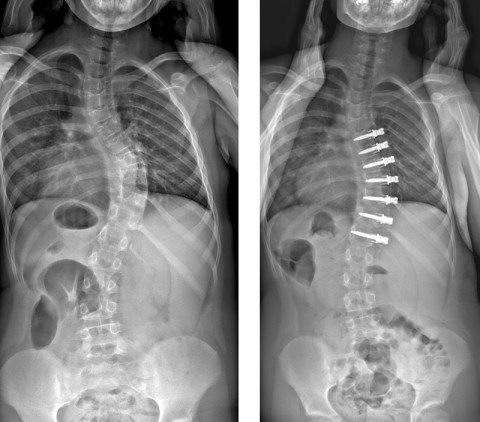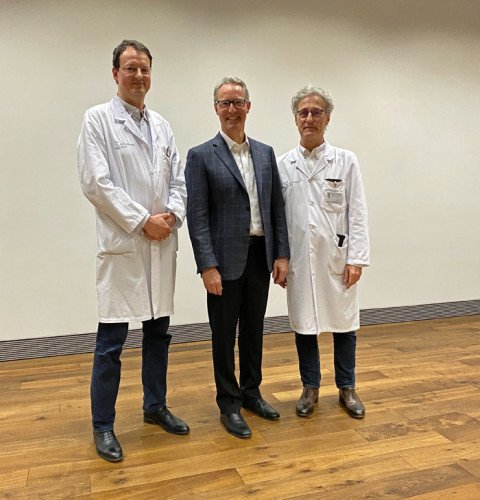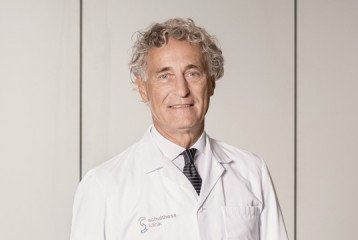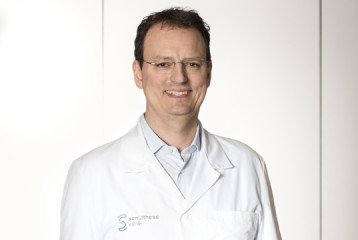News Scoliosis surgery that preserves mobility
In early March, two scoliosis operations were performed at the Schulthess Klinik based on a new procedure – one that had never been used before in Switzerland – that is designed to preserve mobility. Unlike operations involving fusion, this approach makes it possible to maintain more flexibility in the spine. The two operations were carried out by Peter O. Newton, a visiting doctor from San Diego, in collaboration with PD Dr. med. Dezsö J. Jeszenszky, PhD and Dr. med. Tamás Fekete from our Spine Surgery, Orthopaedics and Neurosurgery department.
Idiopathic scoliosis is a curvature of the spine that develops in children and adolescents as they grow, as was the case with the two young patients who underwent surgery at our clinic in March using the innovative anterior vertebral body tethering procedure (also known as dynamic scoliosis correction). It is during this particular phase of childhood growth that the new surgical method comes into its own, as it involves correcting the curvature in a flexible way that is controlled as the patient continues to grow. Unlike the standard procedure used previously, the new approach avoids fusing the affected vertebrae. Instead, the surgeon inserts screws into the side of the vertebral bodies which are connected and tightened using a braided plastic cord. This operation immediately corrects the curvature to a significant extent and the tension provided by the tethering device reduces growth on the side of the spine where it is applied. Only the untreated side carries on growing, enabling the spine to straighten itself as the growth continues. This method therefore works like a kind of corset inside the body. The main benefit is that it keeps the spine as mobile as possible and means that the intervertebral discs are less affected too. Moreover, in an ideal scenario, only one operation will be required. Another advantage is that the operation is a minimally invasive procedure, so only small incisions are made. This reduces blood loss and also causes less pain for the patient afterwards.
The two adolescents who were operated on at our clinic have recovered well and have already resumed their everyday activities, just three months after their operations. Their spinal curvatures have successfully been prevented from getting rapidly worse and there are even already signs of improvement.
Not suitable for everyone
This surgical method is only suitable for a small group of patients. Aside from the degree of the scoliosis curvature, the main factors that this depends on are the patient’s age (ideally approximately 10 to 12 years) and the further growth that is expected, which is determined based on an X-ray of the hand.
Since this procedure is still relatively new and not many patients are eligible, there have not yet been any comprehensive scientific studies into the technique. Nevertheless, the findings that have been made available so far are highly promising.

A long-standing friendship and professional relationship
Peter O. Newton and PD Dr. med. Dezsö J. Jeszenszky have been friends for many years and share a common history. They first met more than 20 years ago when they were both working under Professor Jürgen Harms at the Klinikum Karlsbad-Langenstein, which was the foremost centre for spine surgery at the time. Back then, PD Dr. med. Dezsö J. Jeszenszky introduced Peter O. Newton to a method for operating on scoliosis patients through the chest. Their professional relationship and their mutual efforts to help scoliosis patients as effectively as possible have never faltered over the years.
Peter O. Newton, won over by the idea of operating via the chest, developed this method further in the years to follow. Now that the new procedure designed to preserve mobility has been introduced, he is happy to return to favour to his friend PD Dr. med. Dezsö J. Jeszenszky by passing on the knowledge he has gained to him and his team.
Only a few spine surgeons in the world are using this operating method. As one of the most experienced specialists in the field, Peter O. Newton has spent many years conducting research with a view to developing this procedure and has also been putting it into practice in his own clinical work for over a decade. Dezsö J. Jeszenszky has great respect not only for Peter O. Newton’s extensive experience, but also for his honest assessment of new treatment methods and it was with this in mind that he invited him to the Schulthess Klinik. The two specialists agree that, taking a sceptical yet optimistic approach, it is important to carefully consider which patients this new method could help. Patients’ safety and well-being are always the top priority.


